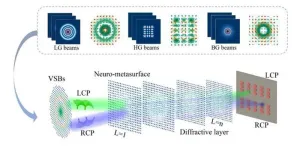(Press-News.org) Boston – Dana-Farber Cancer Institute researchers are leading 3 separate studies with encouraging results in treating patients with central nervous system (CNS) lymphoma, breast cancer, and glioblastoma. The studies support future research in these potential breakthroughs where treatment options may be limited. The research teams will present their findings at the 2024 Annual Meeting of the American Society of Clinical Oncology (ASCO) in Chicago, May 31-June 4, 2024. ASCO is the world’s largest clinical cancer research meeting, attracting more than 30,000 global oncology professionals.
These findings are among more than 80 studies presented at ASCO that are led by Dana-Farber-affiliated researchers.
A full list of Dana-Farber Oral Presentations at the 2024 ASCO Annual Meeting is available here.
A full list of Dana-Farber Poster Discussions at the 2024 ASCO Annual Meeting is available here.
CAR T-cell therapy shows promise in patients with central nervous system lymphoma
A CAR T-cell therapy approved for patients with large B cell lymphoma has produced positive results in a pilot study involving patients with relapsed, treatment-resistant central nervous system (CNS) lymphoma, Dana-Farber investigators report. The therapy, axicabtagene ciloleucel, was found to be safe and well tolerated in the 18 study participants and had an overall response rate of 94%. The median progression-free survival – the time in which patients lived without the cancer worsening – was 14.3 months, and the median overall survival was 26.4 months. The most common side effects, cytokine release syndrome and immune effector cell-associated neurologic syndrome (ICANS) that are inflammatory conditions often associated with CAR T-cell therapy, were manageable. CNS lymphoma is a rare non-Hodgkin lymphoma in which malignant cells form in the lymph tissue of the brain or spinal cord. Although initial treatment is often effective, better treatments are needed when the disease recurs. CAR T-cell therapies use genetically modified versions of a patient's own immune system T cells to attack cancer cells in the body.
Study Title: A Pilot Study of Axicabtagene Ciloleucel (axi-cel) for Relapsed/Refractory Primary and Secondary Central Nervous System Lymphoma
Oral Abstract Number: 2006
Session: Oral Abstract Session - Central Nervous Tumors; June 3, 2024, 10:36am ET
Presenting & Lead Author: Lakshmi Nayak, MD
Co-lead Author: Caron Jacobson, MD, MMSc
Antibody-drug conjugate plus checkpoint inhibitor shows a trend toward improved progression-free survival in PD-L1-positive hormone receptor-positive, HER2-negative breast cancer
In patients with metastatic hormone receptor (HR)-positive/HER2-negative breast cancer unselected by PD-L1 status, adding the immune checkpoint inhibitor pembrolizumab to the antibody-drug conjugate sacituzumab govitecan resulted in a 1.9-month improvement in median progression-free survival that was not statistically significant. In the subgroup of patients with PD-L1-positive tumors (defined as a combined positive score ≥1), a 4.4-month increase in median progression-free survival was observed with sacituzumab govitecan plus pembrolizumab compared to sacituzumab govitecan alone.
The phase II SACI-IO HR+ trial was designed to evaluate whether these two therapies act synergistically. Sacituzumab govitecan consists of an antibody linked to a chemotherapy drug called SN-38. In cancer cells, SN-38 causes DNA damage that, via activation of pathways in the cancer cell, may draw T-cells to the cancer. The combination with pembrolizumab (an immune checkpoint inhibitor that lifts the brakes off the immune system) could enhance the ability of the immune system to recognize and attack cancer cells. The SACI-IO HR+ trial included 110 patients with previously treated advanced or metastatic HR-positive/HER2-negative breast cancer; 104 patients started therapy on the study – half of whom received sacituzumab govitecan plus pembrolizumab and half of whom received sacituzumab govitecan alone.
At a median follow-up of 12.5 months, the median progression-free survival (how long patients lived before their cancer worsened) was 8.1 months for patients receiving the combined therapy, compared to 6.2 months for those receiving sacituzumab govitecan alone. In the approximately 40% of patients who participated in the study whose tumor was PD-L1-positive, the median progression-free survival was 11.1 months with the combination vs 6.7 months with sacituzumab govitecan alone. These results support further investigation of sacituzumab govitecan plus pembrolizumab in patients with PD-L1-positive metastatic HR-positive/HER2-negative breast cancer.
Study Title: SACI-IO HR+: A randomized phase II trial of sacituzumab govitecan with or without pembrolizumab in patients with metastatic hormone receptor-positive/HER2-negative breast cancer
Abstract Number: LBA1004
Session: Oral Abstract Session - Breast Cancer Metastatic; June 1, 2024, 5:00pm ET
Presenting Author: Ana Garrido-Castro, MD
Senior Author: Sara Tolaney, MD, MPH
Drug targeting protein involved in control of immune response produces encouraging results in glioblastoma
A drug that targets a protein involved in regulating the immune response might be promising in patients with glioblastoma, Dana-Farber investigators report. The drug ibudilast inhibits a protein called MIF, which is produced at elevated levels in patients with glioblastoma and can hamper the immune response to cancer. In a phase 1b/2a study, 36 patients with newly diagnosed glioblastoma and 26 patients with recurrent glioblastoma were treated with daily ibudilast and monthly cycles of temozolomide, a chemotherapy agent. The six-month progression-free survival was 44% for patients with newly diagnosed glioblastoma and 31% for those with recurrent glioblastoma. Although the survival rates were comparable to historically reported rates, laboratory research suggests the drug may be more effective in patients with glioblastoma when combined with immunotherapy agents known as checkpoint inhibitors, making this combination a potentially promising therapy.
Study Title: Phase 1b/2a study evaluating the combination of MN-166 (Ibudilast) and temozolomide in patients with newly diagnosed and recurrent glioblastoma
Oral Abstract Number: 2016
Session: Rapid Oral Abstract Session - Central Nervous System Tumors; June 2, 2024, 1:00pm ET
Presenting Author: Gilbert Youssef, MD
Senior Author: Patrick Wen, MD
ASCO Awards and Fellows
ASCO recognized Janet L. Abrahm, MD, FACP, FAAHPM, of Dana-Farber and Brigham and Women’s Hospital, as a recipient of an ASCO Special Award, the Society’s highest honor. Abrahm was awarded the Walther Cancer Foundation Supportive Oncology Award, noting her as a distinguished leader in palliative and supportive oncology through the prevention, assessment, and management of cancer- and treatment-related suffering.
Each year ASCO also recognizes members with the Fellow of the American Society of Clinical Oncology (FASCO) distinction. This year Narjust Florez, MD, FASCO, and Shail Maingi, MD, FASCO, are among the recipients recognized for their extraordinary volunteer service, dedication, and commitment to ASCO.
For all ASCO-related media inquiries, call, or email Victoria Warren, 617-939-5531, Victoria_Warren@dfci.harvard.edu. Follow the meeting live on X using the hashtag #ASCO24 and follow Dana-Farber News on X at @DanaFarberNews.
About Dana-Farber Cancer Institute
Dana-Farber Cancer Institute is one of the world’s leading centers of cancer research and treatment. Dana-Farber’s mission is to reduce the burden of cancer through scientific inquiry, clinical care, education, community engagement, and advocacy. We provide the latest treatments in cancer for adults through Dana-Farber Brigham Cancer Center and for children through Dana-Farber/Boston Children’s Cancer and Blood Disorders Center. Dana-Farber is the only hospital nationwide with a top 10 U.S. News & World Report Best Cancer Hospital ranking in both adult and pediatric care.
As a global leader in oncology, Dana-Farber is dedicated to a unique and equal balance between cancer research and care, translating the results of discovery into new treatments for patients locally and around the world, offering more than 1,100 clinical trials.
###
END
Clinical trials show promise in treating central nervous system lymphoma, breast cancer, and glioblastoma
The findings to be presented at the 2024 Annual Meeting of the American Society of Clinical Oncology (ASCO).
2024-06-01
ELSE PRESS RELEASES FROM THIS DATE:
Crisis intervention program leverages social media to reduce suicide risk
2024-06-01
An Oregon-based program that monitors social media use may have helped deter more than 150 youth suicide attempts in the five years it’s operated, reports a new study published online today in the journal Psychiatric Services.
Staff with Lines for Life, a nonprofit that operates mental health crisis support services, and researchers at Oregon Health & Science University collaborated to closely document interventions by the Safe Social Spaces program, launched in 2019 by Lines for Life.
The study’s senior author said it’s an example of meeting people where they are.
“Community engagement is critical,” said Alan Teo, M.D., M.S., associate professor of ...
An unlikely hero in evolution: worms
2024-06-01
One of Earth’s most consequential bursts of biodiversity—a 30-million-year period of explosive evolutionary changes spawning innumerable new species—may have the most modest of creatures to thank for the vital stage in life’s history: worms.
The digging and burrowing of prehistoric worms and other invertebrates along ocean bottoms sparked a chain of events that released oxygen into the ocean and atmosphere and helped kick-start what is known as the Great Ordovician Biodiversification Event, roughly 480 million years ago, according ...
Detecting machine-written content in scientific articles
2024-06-01
The recent surge in popularity of AI tools such as ChatGPT is forcing the science community to reckon with its place in scientific literature. Prestigious journals such as Science and Nature have attempted to restrict or prohibit AI use in submissions, but are finding it difficult to enforce because of how challenging it is becoming to detect machine-generated language.
Because AI is getting more advanced at mimicking human language, researchers at the University of Chicago were interested in learning ...
Sorting complex light beams: A breakthrough in optical physics
2024-06-01
In the dynamic realm of optical physics, researchers are continually pushing the boundaries of how light can be manipulated and harnessed for practical applications. As reported in Advanced Photonics Nexus, a groundbreaking study from the Harbin Institute of Technology (HIT) introduces a method for sorting and distinguishing various types of vector structured beams (VSBs), promising significant advancements in optical communication and quantum computing.
Unlike conventional light beams that propagate in simple, straight trajectories, VSBs are engineered to form complex, intricate patterns. These beams transmit ...
Supervised physical exercise improves the wellbeing of carers of the elderly
2024-06-01
Mainly older and middle-aged women, working class, with a very high prevalence of lower back pain and consequently possible psycho-affective problems and a poorer quality of life... This is the general profile of carers of the elderly. Who cares for the carer? This question or demand is not new in our society. Members of the Ageing On research group of the University of the Basque Country (UPV/EHU) asked themselves the following question: “How can we care for the carers?”
The Ageing On group develops, ...
Polygenic risk scores give inaccurate and highly inconsistent results in embryo selection
2024-06-01
Polygenic risk scores (PRSs) are estimates of an individual’s susceptibility to a specific complex trait obtained by aggregating the effects of dozens, thousands, and potentially millions of genetic variants associated with that specific trait into a single figure. Some private companies now market PRS embryo screening to prospective parents through the use of in vitro fertilisation and pre-implantation genetic testing. While PRS has great potential for prediction in live-born (mostly adult) individuals, its accuracy ...
Molecular profiling improves diagnosis and survival for children with high risk cancers
2024-06-01
Berlin, Germany: Cancer is the leading cause of disease-related death in children in most developed countries, and at least a quarter of these patients are diagnosed with aggressive high-risk or relapsed cancers, with an expected five-year survival rate of less than 30%. Accurate diagnosis can be difficult, and survivors often suffer life-long side effects because of the toxic treatments needed to cure them. Now, researchers from Australia have shown that, by using precision medicine*, it is possible not only to obtain more accurate diagnoses, but also that using precision-guided, targeted treatments earlier improves the two year progression-free ...
New FRIB precision measurement program advances understanding of proton halos
2024-05-31
In May 2022, the Facility for Rare Isotope Beams (FRIB) at Michigan State University (MSU), launched its precision measurement program. Staff from FRIB’s Low Energy Beam and Ion Trap (LEBIT) facility take high-energy, rare-isotope beams generated at FRIB and cool them to a lower energy state. Afterward, the researchers measure specific particles’ masses at high precision.
The LEBIT team, led by Ryan Ringle, adjunct professor of physics at FRIB and in the MSU Department of Physics and Astronomy and senior ...
A greener, more effective way to kill termites
2024-05-31
UC Riverside scientists have discovered a highly effective, nontoxic, and less expensive way to lure hungry termites to their doom.
The method, detailed in the Journal of Economic Entomology, uses a pleasant-smelling chemical released by forest trees called pinene that reminds western drywood termites of their food. They follow the scent to a spot of insecticide injected into wood.
“We saw significant differences in the death rates using insecticide alone versus the insecticide plus pinene,” said UCR entomologist Dong-Hwan Choe, who led the discovery. “Without pinene, we got about 70% mortality. When we added it in, it was over 95%.
Native ...
Engineered circulatory systems may help fight disease
2024-05-31
The pharmaceutical drug development and approval process is a multi-step undertaking that requires a plethora of testing before reaching the market. Even then, humans respond differently to drugs depending on their individual bodies and medical needs.
Dr. Abhishek Jain, associate professor in the Department of Biomedical Engineering, and his lab received a grant from Texas A&M Innovation to continue developing an advanced vessel-chip deployment platform for large-scale pharmaceutical testing services that holds promise for ...
LAST 30 PRESS RELEASES:
Coffee as a staining agent substitute in electron microscopy
Revealing the diversity of olfactory receptors in hagfish and its implications for early vertebrate evolution
Development of an ultrasonic sensor capable of cuffless, non-invasive blood pressure measurement
Longer treatment with medications for opioid use disorder is associated with greater probability of survival
Strategy over morality can help conservation campaigns reduce ivory demand, research shows
Rising temperatures reshape microbial carbon cycling during animal carcass decomposition in water
Achieving ultra-low-power explosive jumps via locust bio-hybrid muscle actuators
Plant-derived phenolic acids revive the power of tetracycline against drug-resistant bacteria
Cooperation: A costly affair in bacterial social behaviour?
Viruses in wastewater: Silent drivers of pollution removal and antibiotic resistance
Sub-iethal water disinfection may accelerate the spread of antibiotic resistance
Three in four new Australian moms struggle with body image
Post-stroke injection protects the brain in preclinical study
Cardiovascular risk score predicts multiple eye diseases
Health: estimated one in ten British adults used or interested in GLP-1 medications for weight loss
Exercise to treat depression yields similar results to therapy
Whooping cough vaccination for pregnant women strengthens babies’ immune system
Dramatic decline in new cases of orphanhood in Uganda driven by HIV treatment and prevention programs
Stopping weight loss drugs linked to weight regain and reversal of heart health markers
Higher intake of food preservatives linked to increased cancer risk
Mass General Brigham–developed cholera vaccine completes phase 1 trial
First experimental validation of a “150-year-old chemical common sense” direct visualization of the molecular structural changes in the ultrafast anthracene [4+4] photocycloaddition reaction
Lack of support for people on weight loss drugs leaves them vulnerable to nutritional deficiencies, say experts
Dogs’ dinners can have greater climate impact than owners’
Are you ready to swap salmon for sprats and sardines?
1.6 million UK adults used weight loss drugs in past year
American College of Cardiology comments on new dietary guidelines for Americans
American Society of Gene & Cell Therapy and Orphan Therapeutics Accelerator partner to advance and commercialize promising rare disease treatments
One in 14 patients having day case surgery have new or worse chronic pain 3 months after their operation
New study highlights link between eviction rates and gun violence
[Press-News.org] Clinical trials show promise in treating central nervous system lymphoma, breast cancer, and glioblastomaThe findings to be presented at the 2024 Annual Meeting of the American Society of Clinical Oncology (ASCO).





